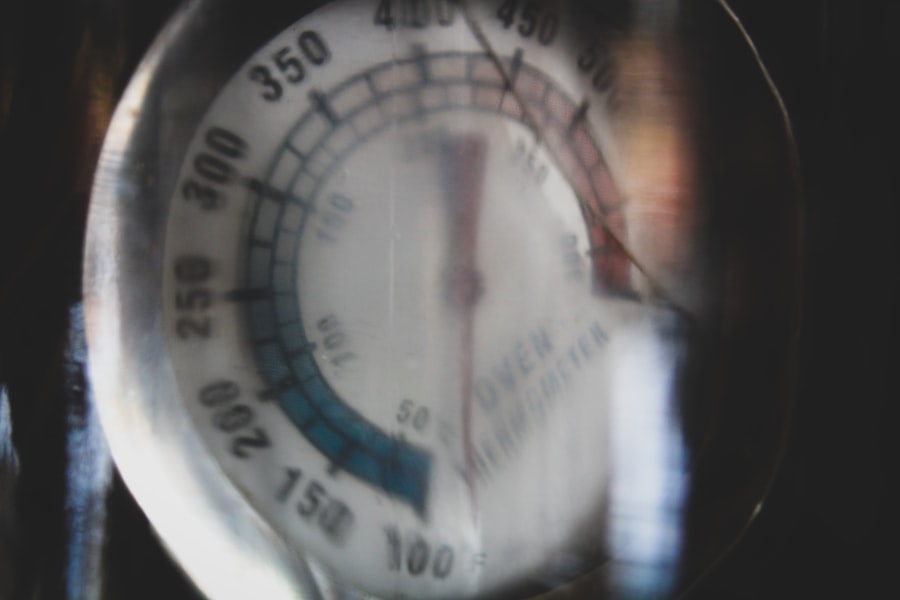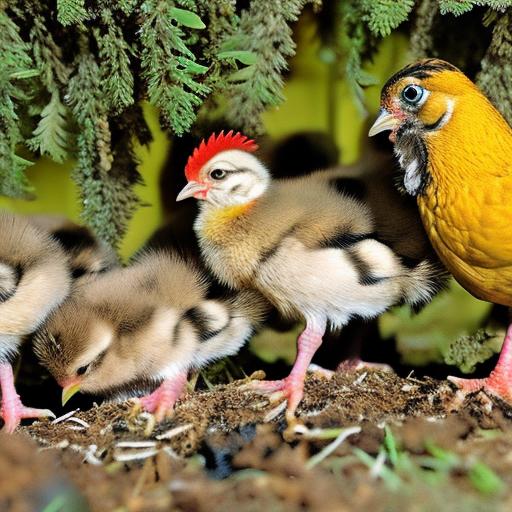Maintaining the right temperature is crucial for the health and well-being of chickens, especially for young chicks. Chickens are warm-blooded animals and rely on their environment to regulate their body temperature. If the temperature is too hot or too cold, it can have serious consequences for their health.
For young chicks, maintaining the right temperature is even more important. Chicks are not able to regulate their body temperature as effectively as adult chickens, and they rely on external heat sources to stay warm. If they are exposed to temperatures that are too cold, they can suffer from hypothermia and even die. On the other hand, if they are exposed to temperatures that are too hot, they can suffer from heat stress and dehydration.
Key Takeaways
- Keeping the right temperature is crucial for the health and well-being of chickens.
- Setting up the brooder correctly is essential for maintaining the right temperature.
- Choosing the right heat source is important to ensure the temperature is consistent and safe.
- Measuring the temperature in the brooder regularly is necessary to make adjustments as needed.
- The recommended temperature for 2-week-old chickens is around 85-90°F, but it can vary depending on the breed and environment.
Setting Up the Brooder
Setting up a brooder is the first step in creating a warm and safe environment for young chicks. The brooder should be a container that is large enough to accommodate the number of chicks you have, but not so large that they are unable to generate enough body heat to stay warm. A good rule of thumb is to provide at least 1 square foot of space per chick.
The brooder should be lined with bedding material such as pine shavings or straw. This will provide insulation and absorb any moisture from droppings. It’s important to choose bedding material that is safe for chicks and easy to clean.
Water and food sources should also be provided in the brooder. Chicks need access to clean water at all times to stay hydrated, and a shallow dish or waterer should be used to prevent drowning. A chick starter feed should be provided as their main source of nutrition.
Choosing the Right Heat Source
Choosing the right heat source for your brooder is essential for maintaining the right temperature. There are several options available, including heat lamps and heating pads.
Heat lamps are a popular choice for brooders as they provide a direct source of heat. They can be easily adjusted to raise or lower the temperature in the brooder. However, heat lamps can be a fire hazard if not used properly, and they can also cause burns if they come into direct contact with the chicks.
Heating pads are another option for providing heat in the brooder. They are placed underneath the bedding and provide a gentle and consistent source of heat. Heating pads are safer than heat lamps as they do not pose a fire hazard, but they may not provide enough heat in colder climates.
Measuring Temperature in the Brooder
Measuring the temperature in the brooder is essential for ensuring that it is at the right level for the chicks. There are several tools available for measuring temperature, including thermometers and temperature guns.
Thermometers can be placed inside the brooder to monitor the temperature. It’s important to choose a thermometer that is accurate and easy to read. Digital thermometers are a popular choice as they provide an instant reading and can be easily calibrated.
Temperature guns are another option for measuring temperature in the brooder. They use infrared technology to measure the surface temperature of objects. Temperature guns are quick and easy to use, but they may not provide an accurate reading of the air temperature in the brooder.
Recommended Temperature for 2-Week-Old Chickens
The ideal temperature for 2-week-old chickens is around 85-90 degrees Fahrenheit (29-32 degrees Celsius). However, it’s important to note that this temperature can vary depending on the breed of chicken.
Some breeds are more cold-hardy and can tolerate lower temperatures, while others are more heat-sensitive and require higher temperatures. It’s important to research the specific needs of your breed of chicken to ensure that you are providing the right temperature in the brooder.
Adjusting Temperature in the Brooder

It’s important to regularly monitor the temperature in the brooder and make adjustments as needed. If the temperature is too low, you can raise the heat source or lower the height of the lamp to increase the temperature. If the temperature is too high, you can lower the heat source or raise the height of the lamp to decrease the temperature.
It’s important to make gradual adjustments to avoid shocking the chicks. Sudden changes in temperature can cause stress and health problems. It’s also important to observe the behavior of the chicks to determine if they are comfortable. If they are huddled together and chirping loudly, it may be a sign that they are too cold. If they are panting and spreading out, it may be a sign that they are too hot.
Common Mistakes to Avoid
When setting up and maintaining a brooder, there are several common mistakes that new chicken owners should avoid. One common mistake is overcrowding the brooder. Overcrowding can lead to increased competition for food and water, as well as increased stress and disease transmission.
Using the wrong type of bedding is another common mistake. Some types of bedding, such as cedar shavings, can be toxic to chickens and should be avoided. It’s important to choose bedding that is safe, absorbent, and easy to clean.
Another common mistake is not providing enough ventilation in the brooder. Good ventilation is essential for maintaining air quality and preventing the buildup of ammonia from droppings. However, it’s important to strike a balance between ventilation and draftiness, as drafts can cause chilling.
Using a Thermostat to Regulate Temperature
Using a thermostat is an effective way to regulate temperature in the brooder. A thermostat can be used to automatically turn on or off the heat source based on the temperature in the brooder.
There are several types of thermostats available, including manual thermostats and digital thermostats. Manual thermostats require manual adjustments to maintain the desired temperature, while digital thermostats can be programmed to maintain a specific temperature range.
Using a thermostat can help ensure that the temperature in the brooder remains consistent and within the recommended range. This can help prevent temperature fluctuations that can be harmful to the chicks.
Moving Chickens to the Coop
Once the chicks are around 6-8 weeks old and have developed their feathers, they can be moved from the brooder to the coop. It’s important to wait until they are fully feathered to ensure that they are able to regulate their body temperature and stay warm.
When moving the chickens to the coop, it’s important to do it gradually to minimize stress. Start by placing the brooder inside the coop for a few days so that the chickens can become familiar with their new surroundings. Then, open the door of the brooder and allow them to explore the coop on their own.
Preparing the Coop for 2-Week-Old Chickens
Before moving the 2-week-old chickens to the coop, it’s important to prepare it properly. The coop should be clean, dry, and well-ventilated. It should also be predator-proof to ensure the safety of the chickens.
Bedding should be added to the coop to provide insulation and absorb moisture. Pine shavings or straw are good options for bedding material. Food and water sources should also be set up in the coop so that the chickens have easy access to them.
In conclusion, maintaining the right temperature is crucial for the health and well-being of chickens, especially for young chicks. Setting up a brooder with the right size and type of container, bedding, and water and food sources is essential for creating a warm and safe environment. Choosing the right heat source and measuring temperature in the brooder are also important factors to consider. It’s important to regularly monitor and adjust the temperature in the brooder to ensure that it remains within the recommended range. By avoiding common mistakes and using a thermostat to regulate temperature, chicken owners can provide the best possible care for their chickens.
If you’re wondering what temperature to keep your chickens at 2 weeks old, there are several factors to consider. One important aspect is the type of coop you have for your chickens. The Producers Pride Sentinel Chicken Coop, featured in this informative article, provides valuable insights on maintaining the ideal temperature for young chicks. Additionally, if you’re considering converting a shed into a chicken coop, this article offers helpful tips and guidance on creating a suitable environment for your feathered friends. Furthermore, the article on the floor of the chicken coop explores different flooring options that can contribute to maintaining the right temperature for your 2-week-old chickens. Check out these articles for expert advice and practical solutions to ensure the well-being of your flock.
FAQs
What is a brooder?
A brooder is a heated enclosure used to keep young poultry warm and safe during their first few weeks of life.
What temperature should I keep my 2-week-old chickens in the brooder?
At 2 weeks old, chickens should be kept in a brooder with a temperature of around 75-80°F (24-27°C).
What happens if the brooder temperature is too low?
If the brooder temperature is too low, the chicks may become chilled and huddle together for warmth. This can lead to illness and even death if not corrected.
What happens if the brooder temperature is too high?
If the brooder temperature is too high, the chicks may become overheated and pant or spread out to cool down. This can also lead to illness and death if not corrected.
How do I measure the temperature in the brooder?
You can measure the temperature in the brooder using a thermometer placed at the same level as the chicks.
How often should I check the temperature in the brooder?
You should check the temperature in the brooder at least twice a day, and more often if the weather or other conditions change.
Meet Walter, the feathered-friend fanatic of Florida! Nestled in the sunshine state, Walter struts through life with his feathered companions, clucking his way to happiness. With a coop that’s fancier than a five-star hotel, he’s the Don Juan of the chicken world. When he’s not teaching his hens to do the cha-cha, you’ll find him in a heated debate with his prized rooster, Sir Clucks-a-Lot. Walter’s poultry passion is no yolk; he’s the sunny-side-up guy you never knew you needed in your flock of friends!







